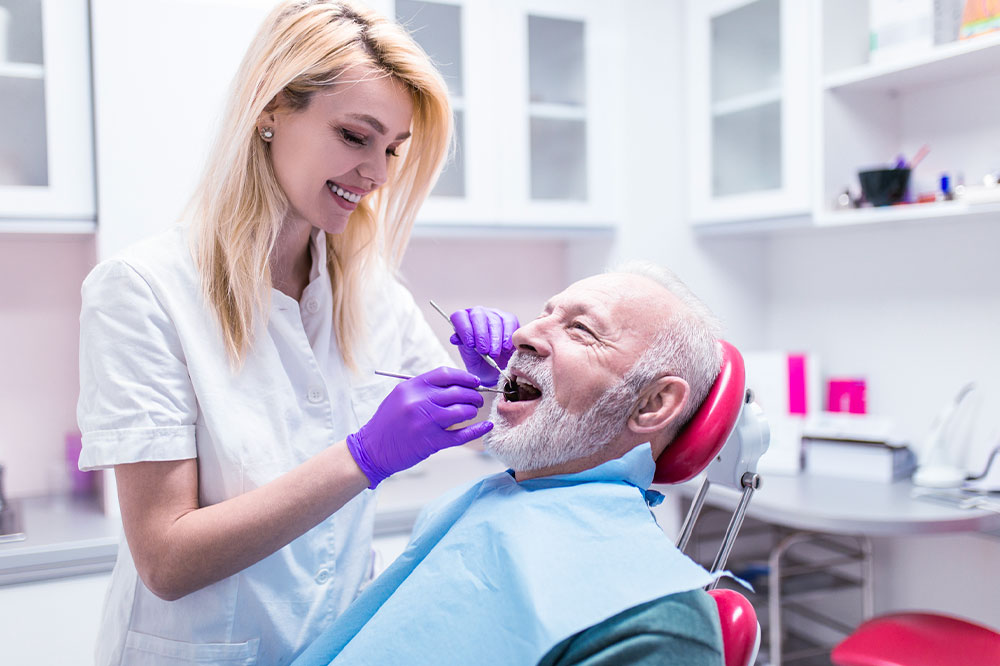8 Benefits of Dental Implants for Seniors

Dental implant surgeries are one of the most commonly done procedures for anyone who requires artificial teeth to fill in gaps in the upper or lower jaw. These artificial ceramic crowns are remarkably similar in construction and quality when compared to real teeth and offer a more permanent solution over dentures. Seniors who are accustomed to using dentures can certainly consider this treatment option to help smile more confidently and regain complete teeth function.
Dental implants and their types
Dental implants are basically a set of artificial teeth that are permanently affixed to the jawbone using screws and supports to replace any gaps. These implants can be affixed individually to replace only a few missing teeth or orthodontists can create a complete set of implants for seniors who have lost most of their healthy molars. Titanium is the main metal used to mold and shape the screws that are fused with the jawbone. The artificial teeth can be then tightened to these screws with grooves in the ceramic molars.
Types of dental implants
Dental implants can be either endosteal or subperiosteal. Most seniors are eligible for endosteal implants, especially if they are missing more than a few teeth. Dentists will fuse multiple titanium screws around the jawbone to create a foundation template for all the artificial crowns. Endosteal implants are the most commonly used allowing dentists to reconstruct the missing molars and restore mouth function.
Alternatively, subperiosteal implants, are not fused to the jawbone but inserted into the gums to hold the artificial teeth. This procedure is reserved for seniors who don’t have sufficient healthy jawbone to hold the artificial teeth in place. It is also considered as a viable alternative for patients who request against bone augmentation procedure for fusing the titanium screws.
Both types of implants can help restore a senior person’s smile. It can also help facilitate the complete functionality of the upper and lower jaw to perform everyday tasks like chewing, drinking, and talking with ease.
Compelling reasons why dental implants are worth the investment
There are many advantages and benefits of opting for dental implants over use of dentures.
Investing in implants is worthy
They say a person’s smile is one of the first things anybody notices at first glance. But without a full set of teeth, seniors become conscious about their smile. They often restrain themselves from doing so, even among close friends and family. Implants replace old lost teeth and bring back this important aesthetic. After all, a smile is worth every penny these days, and implants are something that many people can afford, since some of them are covered under insurance.
Good for appearance
Without teeth, even the most basic of activities like having food and talking can become difficult after a certain age. This is where dental implants can come handy as they help restore natural appearance and functionality of the mouth. The implants also help boost self-confidence of seniors who are extra conscious about their appearance.
Improved comfort
Dental implants unlike dentures are permanent fixtures and require very little active maintenance once they are affixed to the jawbone. This means seniors can comfortably go about their daily routine and maintain basic oral hygiene to keep the false set of teeth clean. Implants also don’t trigger gum muscle irritation or pain, usually caused by seniors fussing around with removable dentures.
Protects other healthy teeth
If elderly seniors still have few healthy natural teeth left, it is better to use dental implants to complete the entire upper or lower row of teeth. With dentures, the biggest disadvantages is removing any molars that are still strong enough to hold on to the roots at the base of the molar. Dental implants can be attached right next to the remaining healthy teeth, and can also help create a bridge to strengthen other molars.
Implants last for a lifetime
Dental implants are designed with premium metal and ceramic materials that don’t corrode or erode with proper oral hygiene. Meaning, once the procedure is done, seniors don’t have to worry about their smile for life. With implants, only the crowns may need to be changed once every ten or fifteen years. But even that is a better timeline than most types of permanent dental products.
No need to eliminate foods
Eating with dentures is a massive headache as doctors advise seniors to not have foods that can dislodge the temporary teeth. These include sticky foods and anything that is crunchy requiring a certain amount of force to chew and swallow. However, implants do not pose these restrictions as they are firmly affixed to the base of the jawbone and provide a strong support for the artificial teeth. Seniors can easily enjoy their favorite foods and not worry about damage to the implants. Implants are also a very realistic replacement of natural teeth.
Proven results
Dental implants are one of the most common surgical procedures conducted these days. More number of surgeries with fewer or even no complications instill a sense of confidence among the patients. Proven results only confirm how and why these implants are instrumental in restoring smiles with such treatments.
Affordability and the need for dental implants
Dental implants are an approved procedure for seniors of most ages. If they can sit through the lengthy surgery and are able to maintain a healthy lifestyle post procedure, these implants can boost their confidence and bring about a positive change in their lifestyle. Also, these days, most types of dental implant procedures have become affordable with some clinics offering easy installment payments divided across a fixed tenure. For example, Medigap and Medicare Advantage Plans cover many cosmetic procedures under dental insurance. Seniors can essentially save over half the cost in exchange for a small additional premium to cover the procedure.






